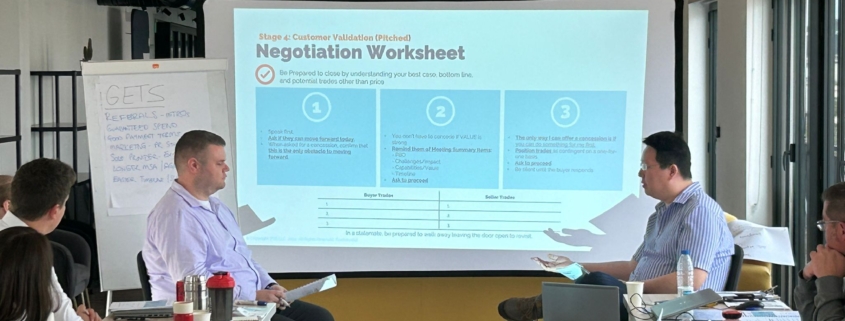We recently had the opportunity to sit down with Tom Martin, former president of Miller Heiman and 20+ year veteran of the sales methodology and training industry. During our time together, we discussed many of the big ideas pervading the space today.
Below, please find an excerpt from our conversation on one of today’s biggest topics – social selling.
John: There are a lot of trends affecting B2B salespeople, and one with a huge buzz is social selling. Can you walk us through what “social selling” means to you?
Tom: You’re right John, social selling has a big buzz about it, and does not seem to be going away. In most industries, sellers need to adapt to how social selling is impacting their sales process because of how it is affecting their prospect’s buying process. Sales managers also need to adapt their sales training and reinforcement activities to coach their sellers in this new competency area.
John: Tom, tell us what social selling means to you. How can salespeople utilize social networks to improve their overall results?
Tom: When I think about what social selling means, I look at three different dimensions – three ways sellers can utilize “social” in their selling.
The first is listening. As Stephen Covey wrote in The 7 Habits of Highly Effective People, “Seek first to understand, then to be understood”.
Adapting this to social selling, the advice to sellers is simple: use tools like Twitter, LinkedIn, and blogs to read what your prospects are reading and writing … and then after you understand what is important then, and only then, should you start “talking” in the social world.
Another key for listening is another quote from Covey, “Most people do not listen with the intent to understand; they listen with the intent to reply”.
John: Interesting…that ties in nicely with Flannery Sales System’s methodology on how important it is to qualify prospects by listening and uncovering their pain before presenting solutions. You mentioned three dimensions. What are the other two?
Tom: The second is researching. While closely related to listening, I think the use of social tools for research is so critical for sellers it needs to be called out separately. Typically this means using social to support their sales process, or opportunity and account management methodologies.
Researching also includes “searching & stalking” – and by that I mean searching out your friends (champions and coaches), and stalking your enemies (gathering competitive intel).
Finally, the third is telling. Only after you’ve understood your prospects by listening and researching should you start responding with your own social content.
John: This sounds very similar to how I would advise a seller to approach a sales call or meeting – seeking to listen and understand first and only then to solve the problems they have uncovered. Anything else we should know about social selling?
Tom: Some people start with social selling assuming it is the silver bullet they were looking for, and that all they need to do is post a few blogs and tweet once a week. These people inevitably end up disappointed.
I think about a concept I learned as an Advertising major – “impressions.” It was said that it takes seven impressions for someone to fully ‘get’ who you are, what you do, and why they might need your services.
Adapting this to social selling means sellers need to consider integrating their social selling and traditional selling efforts to complement each other and achieve more impressions. They can’t plan on a single tweet magically converting new prospects into opportunities.
One final Covey-ism for today, “Begin with the end in mind.” To drive revenue and add qualified opportunities to the pipeline, your social sales message needs to be in sync with your overall sales message.
John: Any advice on integrating social selling into your sales process?
Tom: To create a lasting impact, you need to build social selling activities into your normal sales cadence – so set aside time each week to listen, research and tell across multiple platforms. In business that typically means LinkedIn posts, blog entries, and Twitter, and possibly SlideShare and YouTube channels.
Stay tuned for more from my conversation with industry expert Tom Martin.









